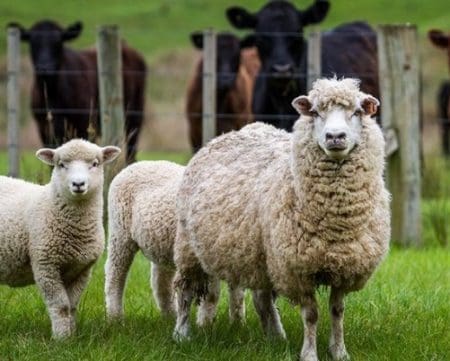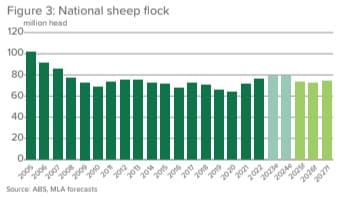 AUSTRALIA’S sheep flock is forecast to fall by 7.4 percent to 73.2 million head this year due to the increased turn-off of older breeding ewes and tough seasonal conditions across key production areas, according to Meat & Livestock Australia.
AUSTRALIA’S sheep flock is forecast to fall by 7.4 percent to 73.2 million head this year due to the increased turn-off of older breeding ewes and tough seasonal conditions across key production areas, according to Meat & Livestock Australia.
In its latest industry projections released today, MLA also forecasts sheep slaughter to decline 17pc to 9.8 million head, following the record rates of sheep turn-off late last year.
The flock is expected to remain relatively stable in 2026, easing 1.8pc to 71.9 million head before lifting by 3pc to 74.1 million head by 2027.
Lamb slaughter is forecast to reach 26.2 million head, a 0.5pc decline from 2024, the second-largest slaughter year on record behind 2024. MLA said given the elevated levels of sheep slaughter at the end of 2024, it is expected that lambs not processed last year will be processed in the first months of 2025.
In 2026, lamb slaughter is expected to ease 3.4pc to 25.3 million head and rise in 2027 by 0.7pc to 25.5 million head. Despite slaughter easing, production is expected to remain high due to productivity improvements, MLA said.
 MLA said sheep slaughter is forecast to decline by 16.9pc to 9.8 million head in 2025, following the earlier than expected turn-off of older breeding ewes. In 2026; however, sheep slaughter is expected to rebound 2.3pc to 10 million head and rise by 2.8pc to 10.3 million head in 2027.
MLA said sheep slaughter is forecast to decline by 16.9pc to 9.8 million head in 2025, following the earlier than expected turn-off of older breeding ewes. In 2026; however, sheep slaughter is expected to rebound 2.3pc to 10 million head and rise by 2.8pc to 10.3 million head in 2027.
MLA is expecting Australia’s cattle herd and sheep flock to decline as record production, slaughter and exports meet demand.
The cattle herd is projected to fall by 1.4pc to 30.1 million head in 2025 due to increased turn-off of older breeding cows and dry conditions in southern Australia.
Red meat ready to respond to global demand
MLA managing director Michael Crowley said the industry projections show that the red meat industry is ready to respond to global demand in 2025.
“Record production and elevated slaughter rates are being met with strong demand from well-established relationships with customers throughout the global supply chain,” he said.
There has been increased sales of joined ewes in western Victoria and south-east South Australia recently as seasonal conditions and MLA said older breeding ewes retained from the 2020–22 rebuild will finally exit the system in 2025, contributing to the flock decline.
However, despite the decline in the national sheep flock, lamb production continues to operate at historically high levels reaching 628,648 tonnes in 2025. This is in part driven by genetic changes in the flock with a focus on improving weight gain and yield in lamb carcases, MLA said.
“Given the elevated levels of sheep slaughter at the end of 2024, it is expected that lambs not processed last year will be processed in the first months of 2025,” Mr Crowley said.
“In addition, Australia and New Zealand account for more than 80pc of global sheep meat exports.
“However, the long-standing decline of the New Zealand sheep flock provides an opportunity for Australian sheep meat exporters to continue their global dominance in 2025.”
Beef herd to fall
MLA is forecasting the cattle herd to fall by 1.4pc to 30.1 million head in 2025 due to increased turn-off of older breeding cows and dry conditions in southern Australia.
Australia produced more beef than ever in 2024, despite slaughter volumes being 7pc below the previous record in 2014. This was due to higher carcase weights, primarily due to increased grain fed production.
Mr Crowley said producers are growing more efficient and productive cattle compared to 10 years ago.
“This is important considering the significant global demand for beef will continue this year, leading to another record production year.
“Australia is currently in an opposite supply cycle to major beef-producing competitors such as the United States and Brazil,” he said.
“As the US begins its long-overdue herd rebuild and drought conditions in Brazil ease, global beef supply is expected to tighten.”
Mr Crowley said Australia is well-positioned to achieve record beef production and export volumes once again, but with increasing carcase weights, storage space has become more valuable, and efficient logistics are now essential to maintaining processing flow and preventing bottlenecks in the supply chain.
“Looking ahead, Australia’s investments in domestic production, processing capacity, and global trade relationships have positioned the cattle sector well for the next few years.”
Mr Crowley said by consulting with producers, processors, agents, and government, MLA creates a clear forecast of the national herd and flock, slaughter, production and carcase weights for the cattle and sheep industries.
MLA is hosting two free webinars on Tuesday March 11 and Wednesday March 12 to share the findings and insights with industry.
Sheep Projections Webinar – Wednesday, 12 March at 11am (AEDT)
Click here to view the full sheep industry projections.
Cattle Projections Webinar – Tuesday, 11 March at 11am (AEDT)
Click here to view the full cattle industry projections.
Source – MLA.